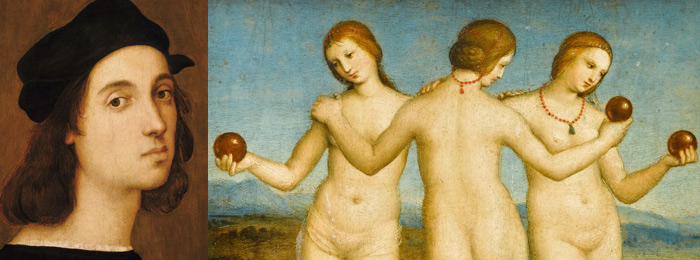On 23 Aug, 2015 With
How to paint in style of Raphael The Three Graces is an oil painting by Italian painter Raphael, housed in the Musée Condé of Chantilly, France. The date of origin has not been positively determined, though it seems to have been painted at some point after his arrival to study with Pietro Perugino in about 1500, possibly 1503-1505. According to James Patrick in 2007’s Renaissance and Reformation, the painting represents the first time that Raphael had depicted the nude female form in front and back views. The Three Graces is an oil painting by Italian painter Raphael. The date of origin has not been positively determined, though it seems to have been painted at some point after his arrival to…
Read More
On 7 Jul, 2011 With
What they learned from the OLD MASTERS? From Raphael. The Portrait of a Young Woman (also known as La fornarina) is a painting by the Italian High Renaissance master Raphael It is probable that the picture was in the painter’s studio at his death in 1520, and that it was modified and then sold by his assistant Giulio Romano. The woman is traditionally identified with the fornarina (bakeress) Margherita Luti, Raphael’s Roman mistress, though this has been questioned. The woman is pictured with an oriental style hat and bare breasts. She is making the gesture to cover her left breast, or to turn it with her hand, and is illuminated by a strong artificial light coming from the external. Her…
Read More
On 13 Jul, 2010 With
Sistine Madonna, also called The Madonna di San Sisto, is an oil painting by the Italian artist Raphael. Finished shortly before his death, ca. 1513–1514, as a commissioned altarpiece, it was the last of the painter’s Madonnas and the last painting he completed with his own hands. Relocated to Dresden from 1754, the well-known painting has been particularly influential in Germany. After World War II, it was relocated to Moscow for a decade before it was returned to Germany. There, it resides as one of the central pieces in the Gemäldegalerie Alte Meister. Composition In the painting, the Madonna, holding the Christ Child and flanked by Saint Sixtus and Saint Barbara, stands on clouds before dozens of obscured cherubs, while two distinctive winged cherubs rest on their elbows beneath her. American travel guideRick…
Read More


